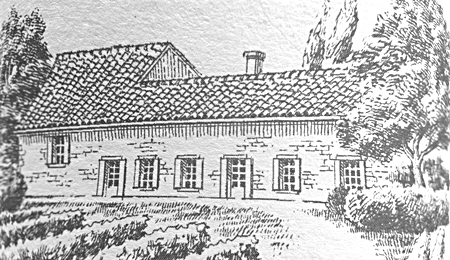Dordogne Discoveries

Ch. Des Illarets.
Now I’ve always had a soft spot for the red wines of Bergerac. In case you’ve
forgotten (or perhaps never knew) it lies in the lovely Dordogne area, which is
in the hinterland of Bordeaux. The modest and charming old town of Bergerac is
about sixty miles from the city of Bordeaux, yet its wines have a distinctive
Bordeaux-style quality, largely because much the same grapes are used; the
familiar trio of Cabernet Sauvignon, Cabernet Franc and Merlot. But what I enjoy
about the Bergerac reds is their lightness of touch. They often have a kind of
friendly homeliness and perhaps this is what sets them apart from their vinous
relatives in Bordeaux. The red wines of Bergerac are almost country cousins.
Almost, but not quite. If we think of red Bordeaux as Mozart, red Bergerac seems
to me more like Haydn.
These two lovely wines are made from grapes grown on a
hillside overlooking the Dordogne in Saint Michel de Montaigne, a small commune
situated on the border between the Gironde and the Dordogne. And I do mean
small. There are less than 400 people living there. Les Illarets is one of the
four hamlets that make up the community. Chโteau Des Illarets (sha-TOH dayz
–ILL-a-ray) was founded in 1936 and has ten acres of vineyards for the
production of red Bergerac and an additional two acres for white wines.
Chโteau Des Illarets, Bergerac
2009 (white), France (Friendship Bt. 395)
Of course, in wine-speak the word “chโteau” doesn’t translate
as a castle; it’s just the name of the building where the wine is made. True,
some of the chโteaux in Bordeaux are imposing palatial mansions but others,
especially those in Bergerac look more like homely farm-houses. They can be
utterly charming.
This is a lovely bright gold, but do give the aroma time to
open up, especially if you’ve just hauled the bottle out of the fridge. You’ll
probably pick up a fresh, grassy floral aroma with pineapple, tropical fruit and
a faint tang of citrus. It has a lovely smooth mouth-feel, a refreshing taste of
fruit and herbs and a good balance of acidity. I’d guess that this wine is a
blend of Sauvignon Blanc and S้millon which brings an acidy freshness to the
wine. Incidentally, don’t be put off by mention of acid, because it occurs in
most foods, including cornflakes and strawberry jam. It’s occurs naturally in
wine grapes and perks up the flavour to give the wine a refreshing tang.
After the wine has been exposed to the air for about twenty
minutes and the oxygen has done its work, you’ll get plenty of lively fruit on
the taste, with an attractive long citrusy finish too. Drink it as an ap้ritif
if you want but I think it will show its best with food.
Chโteau Des Illarets, Bergerac
2010 (red), France (Friendship Bt. 395)
To my mind, this is a really typical Bergerac and very
charming it is too. It’s a rich, warm, dark ruby-red and has an inviting brambly
sort of aroma with a touch of red fruits. There are also hints of strawberries,
raspberries and dried herbs. But somehow the aroma takes my mind to forested
hills, winding country roads and wood fires on a cool autumn evening; the
“season of mists and mellow fruitfulness”, as John Keats so famously wrote.
It has a lovely soft and silky mouth-feel and just a delicate
layer of satin tannin. I think there’s just the right amount of fruit in this
smooth, rounded wine and as you might expect, it’s completely dry. It’s a blend
of 70% Merlot and 30% Cabernet Sauvignon which accounts for the plump softness
of the texture. There’s a long and satisfying dry finish that contains another
gentle reminder of the soft tannins. It is a light and delicate wine of
considerable charm and you’d never guess that it has 13.5% alcohol content.
At this price, it’s excellent value and a lovely wine too if
you want to try a charming variation on familiar red Bordeaux. “Same-same, but
different,” as people tend to say in this neck of the woods.

